Moira Butterfield's Blog, page 64
March 26, 2015
Look who’s laughing now - Crossover humour in picture books • Elys Dolan
A big THANK YOU to this month's guest blogger, Elys Dolan, author-illustrator of the very funny
Weasels
and Nuts in Space. Elys explores how picture book humour can appeal to both young and old in this post.
I’m a big fan of funny picture books. They’ve brought me moments of hilarity featuring everything from speedo wearing wombats to ugly ducklings that grow up to be even worse looking ducks. I’m so much of a fan I even try to make the odd one myself along with doing a PhD about them. I find such books funny even though I’m apparently a fully paid up grown up with a mortgage, a tax return and a grey hair I found the other day but don’t want to talk about.
So prepare yourself because I’m about to get very nerdy about the kind of picture books that are funny for both children and adults. I’ll be using the term crossover humour to describe it. I’ll wax lyrical about why they are the kind of books I want to make and the implications that come with that.
But before I begin here’s a quick disclaimer:
There are few things more subjective than what is or is not funny. Therefore I can’t guarantee that you won’t think the things I’m purporting to be amusing are quite the opposite. If this happens please accept my apologies and lets hope we never have to sit next to each other on a long plane journey.
There’s many types of humour used in children’s books but I’ve chosen three to use as examples, toilet humour, parody and physical humour, because they illustrate the use of different kinds of humour within the same book to achieve a crossover appeal. These examples are going to come from my own work. The first reason for this is that I’m deeply self-centred. The second is if I were to cover the subject in its entirety, in reference to various picture book makers, you’d be reading this for days and probably run out of food and other essential supplies. Thirdly I can put my own images on the internet without asking for permission and not get into trouble.
Toilet humourI’ll start with the classiest type of humour. From my experience of doing book events this goes down brilliantly with kids. This vignette from my first book, Weasels, almost always gets a laugh because sometimes all you have to do is show them a toilet:

Having said that I find the grown ups in the audience aren’t above it either. You tend to have to be a bit subtler and let their own dirty imaginations do the work. I’ll often get the odd parent laughing at this bit from Weasels when the lights suddenly go out: [image error]

Toilet humour is frequently used in picture books, sometimes lazily and sometimes to great effect. Well know examples include Poo Bum by Stephanie Blake, The Story of the Little Mole Who Knew it Was None of His Business by Werner Holzwarth and Wolf Erlbruch.
ParodyI seem to do this a lot and won’t realise it until half way through development. I’ll think ‘I’m going to do a book set in space’ and some how I end up referencing, and poking fun at, Star Wars, Star Trek, 2001 A Space Odyssey and all the other stuff I’m a fangirl for. This is glaringly obvious in my [image error]second book Nuts in Space. Does this place remind you of anything?:
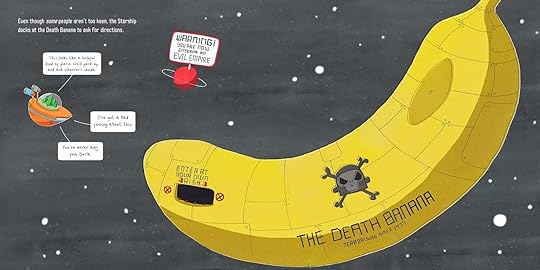
And perhaps this Moose is a little like William Shatner in his own way: [image error]
 And there’s more than a few Bond film references in Weasels including this chap who’s a bit like a certain evil genius/super villain: [image error]
And there’s more than a few Bond film references in Weasels including this chap who’s a bit like a certain evil genius/super villain: [image error]

It’s a fairly adult form of humour because it often requires prior knowledge of external references but I get a great reaction from the reader. Parody like this doesn’t seem very common but there are some excellent examples of parody when it come to reworking fairy tales. The Stinky Cheese Man and Other Fairly Stupid Tales by Jon Scieszka and Lane Smith one of my favourite and there’s Goldilocks and the Three Dinosaurs by Mo Willems.
Physical humour: Slapstick & Humorous PhysicalityUnder slapstick I’m including all Laurel and Hardy style falling over and comedic accidents. For example:
Electrocution

Ducks getting sucked into vacuum cleaners [image error] [image error]

And the classic slipping on a banana skin.

By humorous physicality I mean characters that are funny just from the way they look. I often do this by exaggerating certain features and essentially making them look ridiculous. For example here’s a Baywatch hippo:

I’ve exaggerated the size of said hippo, and trust me it’s no easy thing to make a hippo even chunkier, for comedic value. Putting her in a swimming costume and making her run seems to add to the entertainment too. There’s some great examples of exaggerated characteristics in Melvin Peake’s Captain Slaughterboard Drops Anchor and in Marc Boutavant’s animal characters from Around the World with Mouk.
I find that physical humour appeal much more to children than adults. I’m not entirely sure why, perhaps it’s slightly too direct for adults, and there are of course exceptions but in my own experience it’s the child that react the most to this.
So of the three forms of humour I’ve described parody appeals most to adults, toilet crosses between ages and slapstick appeals mostly to children.
Why on earth would I use crossover humour? I started using crossover humour, and any humour at all for that matter, unconsciously. I didn’t even realise I was doing it until people started telling me. Now the question that looms large for me is why would an author or illustrator include crossover humour in a book for children? I can’t speak for any other practitioners (although I’m planning to glean a range of opinions as part of my research) but I can offer my own philosophy.
I think the initial motivation was my own entertainment. This job is difficult, time consuming, and unlikey to make me rich so I’ve got to be enjoying myself. I do this by putting my own sense of humour into my work and doing things that make me giggle to myself like a crazy lady.
A less self-involved reason is how funny I find the book is a good form of quality control. I sometimes encounter the perception that children have lower standards of humour. I don’t think this is the case. Sometimes different things appeal to children but the standard is always very high and if they’re not enjoying it they will let you know. So, if it’s not good enough to keep me entertained how can I expect my readers to enjoy it?
I’m conscious that my readership isn’t only children. Children’s books are encountered by parents, older ‘reluctant’ readers, booksellers, publishers, other authors & illustrators, reviewers etc. I firmly believe you need to direct the majority of humour towards your core audience but I don’t want the rest to go wanting. If there’s a poor tired parent who’s been asked by their little angel to read one of my books for the 1000th time I hope I can at least raise a brief smile with a gag about death bananas.
Issues with cross over humour: I do occasionally meet resistance from my publishers and others in the industry when using this multi-level humour. Weasels went through a number of rejections and a few of them were because the humour was found to be ‘too adult’. I think subsequently crossover humour has been one of my unique selling points as an author and illustrator but I’ll talk about the pitfalls I’ve encountered.
Kids won’t ‘get it’. If you’re going to put in jokes for grown ups it may be that not all children will understand them. Children and adults have different frames of reference and a form of humour like parody require knowledge of external context for you to get the joke. The question here is does everyone have to get every joke? I know this can be a controversial view but as long as such jokes aren’t in the majority and they provide a different form of interest too I think it’s okay if they don’t.
For instance, in Nuts in Space there’s this moment: [image error]
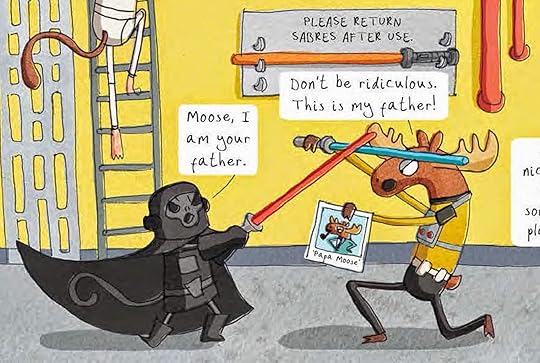
Now this requires a certain knowledge of Star Wars to get this joke. It’s fairly safe to assume not all children will have seen Star Wars so they won’t. On another level though I think an evil space monkey having a duel with a Moose using strip lights is a pretty interesting thing on its own. So, if it’s not going to be funny for everyone then at least make it interesting for the others so it works on two levels. I tend to think of the interest as the first level and the added joke as the second level.
The format makes it hard to to get the balance rightI was talking to an editor recently about why there’s more cross over humour in film and tv (think pixar films etc) than kids books and they said it’s perhaps because a picture book is like a haiku. Every word needs to count whereas in a film it’s one of many. Therefore in a picture book it’s much easier to upset the balance because too much of the content operates on the second level, excluding part of your audience. This is certainly a risk for simpler, more linear, picture books though it’s not impossible to achieve cross over humour in this context. Jon Klassen’s I Want my Hat Back has a kind of deadpan humour that appeals to adults whilst successfully telling a tale about a nefariously stolen hat to children. It works on those two levels and it does this consistently throughout the story. This subtle technique is way beyond the likes of me so I approach it in a different way. I work in a detailed, information heavy, manner so I can sneak in the odd moment of second level humour amongst the falling over and fart jokes.
What’s appropriate?There’s all sorts of theories and differing opinions about what’s appropriate to include in children’s books and this does impact on the kind of humour you can use. For instance some toilet humour could be considered too revolting or some slapstick too violent. I encountered this recently in regards to dog turds. To be precise, this turd here:

It’s the punchline of a joke which I’m not going to reveal in full because it’ll ruin the ending of my new book The Mystery of the Haunted Farm (yes that was a shameless plug). It seems the British reader has no problems with the odd dog poo but the publisher worried Americans would find this dog turd disgusting instead of funny because they have different standards of what’s acceptable. This lead to months of debate and extensive consultation with an American publisher to decide if dog turds are acceptable punch line for a picture book. Eventually it was decided that the turd could stay but it was a close run thing. I had to remove the blue bottles flying around it though. It’s a hard life.
Using cross over humour can be like walking on a knife edge desperately trying to keep your balance. Despite this it’s the times when I’ve done a reading of one of my books and I’ve got both kids and parents laughing that makes all the fretting, rewrites and frantic colouring in worth it. So if you’ll excuse me I’m off to draw a pig wearing underpants falling down toilet whilst dressed like Darth Vader and do it all over again.
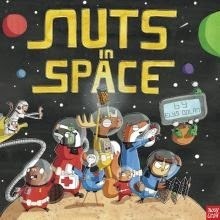 Elys Dolan's latest picture book Nuts in Space is published by Nosy Crow.
Elys Dolan's latest picture book Nuts in Space is published by Nosy Crow.
Find out more about Elys and her books at elysdolan.com
You can also follow Elys on twitter @ElysDolan
I’m a big fan of funny picture books. They’ve brought me moments of hilarity featuring everything from speedo wearing wombats to ugly ducklings that grow up to be even worse looking ducks. I’m so much of a fan I even try to make the odd one myself along with doing a PhD about them. I find such books funny even though I’m apparently a fully paid up grown up with a mortgage, a tax return and a grey hair I found the other day but don’t want to talk about.
So prepare yourself because I’m about to get very nerdy about the kind of picture books that are funny for both children and adults. I’ll be using the term crossover humour to describe it. I’ll wax lyrical about why they are the kind of books I want to make and the implications that come with that.
But before I begin here’s a quick disclaimer:
There are few things more subjective than what is or is not funny. Therefore I can’t guarantee that you won’t think the things I’m purporting to be amusing are quite the opposite. If this happens please accept my apologies and lets hope we never have to sit next to each other on a long plane journey.
There’s many types of humour used in children’s books but I’ve chosen three to use as examples, toilet humour, parody and physical humour, because they illustrate the use of different kinds of humour within the same book to achieve a crossover appeal. These examples are going to come from my own work. The first reason for this is that I’m deeply self-centred. The second is if I were to cover the subject in its entirety, in reference to various picture book makers, you’d be reading this for days and probably run out of food and other essential supplies. Thirdly I can put my own images on the internet without asking for permission and not get into trouble.
Toilet humourI’ll start with the classiest type of humour. From my experience of doing book events this goes down brilliantly with kids. This vignette from my first book, Weasels, almost always gets a laugh because sometimes all you have to do is show them a toilet:

Having said that I find the grown ups in the audience aren’t above it either. You tend to have to be a bit subtler and let their own dirty imaginations do the work. I’ll often get the odd parent laughing at this bit from Weasels when the lights suddenly go out: [image error]

Toilet humour is frequently used in picture books, sometimes lazily and sometimes to great effect. Well know examples include Poo Bum by Stephanie Blake, The Story of the Little Mole Who Knew it Was None of His Business by Werner Holzwarth and Wolf Erlbruch.
ParodyI seem to do this a lot and won’t realise it until half way through development. I’ll think ‘I’m going to do a book set in space’ and some how I end up referencing, and poking fun at, Star Wars, Star Trek, 2001 A Space Odyssey and all the other stuff I’m a fangirl for. This is glaringly obvious in my [image error]second book Nuts in Space. Does this place remind you of anything?:

And perhaps this Moose is a little like William Shatner in his own way: [image error]
 And there’s more than a few Bond film references in Weasels including this chap who’s a bit like a certain evil genius/super villain: [image error]
And there’s more than a few Bond film references in Weasels including this chap who’s a bit like a certain evil genius/super villain: [image error] 
It’s a fairly adult form of humour because it often requires prior knowledge of external references but I get a great reaction from the reader. Parody like this doesn’t seem very common but there are some excellent examples of parody when it come to reworking fairy tales. The Stinky Cheese Man and Other Fairly Stupid Tales by Jon Scieszka and Lane Smith one of my favourite and there’s Goldilocks and the Three Dinosaurs by Mo Willems.
Physical humour: Slapstick & Humorous PhysicalityUnder slapstick I’m including all Laurel and Hardy style falling over and comedic accidents. For example:
Electrocution

Ducks getting sucked into vacuum cleaners [image error] [image error]

And the classic slipping on a banana skin.

By humorous physicality I mean characters that are funny just from the way they look. I often do this by exaggerating certain features and essentially making them look ridiculous. For example here’s a Baywatch hippo:

I’ve exaggerated the size of said hippo, and trust me it’s no easy thing to make a hippo even chunkier, for comedic value. Putting her in a swimming costume and making her run seems to add to the entertainment too. There’s some great examples of exaggerated characteristics in Melvin Peake’s Captain Slaughterboard Drops Anchor and in Marc Boutavant’s animal characters from Around the World with Mouk.
I find that physical humour appeal much more to children than adults. I’m not entirely sure why, perhaps it’s slightly too direct for adults, and there are of course exceptions but in my own experience it’s the child that react the most to this.
So of the three forms of humour I’ve described parody appeals most to adults, toilet crosses between ages and slapstick appeals mostly to children.
Why on earth would I use crossover humour? I started using crossover humour, and any humour at all for that matter, unconsciously. I didn’t even realise I was doing it until people started telling me. Now the question that looms large for me is why would an author or illustrator include crossover humour in a book for children? I can’t speak for any other practitioners (although I’m planning to glean a range of opinions as part of my research) but I can offer my own philosophy.
I think the initial motivation was my own entertainment. This job is difficult, time consuming, and unlikey to make me rich so I’ve got to be enjoying myself. I do this by putting my own sense of humour into my work and doing things that make me giggle to myself like a crazy lady.
A less self-involved reason is how funny I find the book is a good form of quality control. I sometimes encounter the perception that children have lower standards of humour. I don’t think this is the case. Sometimes different things appeal to children but the standard is always very high and if they’re not enjoying it they will let you know. So, if it’s not good enough to keep me entertained how can I expect my readers to enjoy it?
I’m conscious that my readership isn’t only children. Children’s books are encountered by parents, older ‘reluctant’ readers, booksellers, publishers, other authors & illustrators, reviewers etc. I firmly believe you need to direct the majority of humour towards your core audience but I don’t want the rest to go wanting. If there’s a poor tired parent who’s been asked by their little angel to read one of my books for the 1000th time I hope I can at least raise a brief smile with a gag about death bananas.
Issues with cross over humour: I do occasionally meet resistance from my publishers and others in the industry when using this multi-level humour. Weasels went through a number of rejections and a few of them were because the humour was found to be ‘too adult’. I think subsequently crossover humour has been one of my unique selling points as an author and illustrator but I’ll talk about the pitfalls I’ve encountered.
Kids won’t ‘get it’. If you’re going to put in jokes for grown ups it may be that not all children will understand them. Children and adults have different frames of reference and a form of humour like parody require knowledge of external context for you to get the joke. The question here is does everyone have to get every joke? I know this can be a controversial view but as long as such jokes aren’t in the majority and they provide a different form of interest too I think it’s okay if they don’t.
For instance, in Nuts in Space there’s this moment: [image error]

Now this requires a certain knowledge of Star Wars to get this joke. It’s fairly safe to assume not all children will have seen Star Wars so they won’t. On another level though I think an evil space monkey having a duel with a Moose using strip lights is a pretty interesting thing on its own. So, if it’s not going to be funny for everyone then at least make it interesting for the others so it works on two levels. I tend to think of the interest as the first level and the added joke as the second level.
The format makes it hard to to get the balance rightI was talking to an editor recently about why there’s more cross over humour in film and tv (think pixar films etc) than kids books and they said it’s perhaps because a picture book is like a haiku. Every word needs to count whereas in a film it’s one of many. Therefore in a picture book it’s much easier to upset the balance because too much of the content operates on the second level, excluding part of your audience. This is certainly a risk for simpler, more linear, picture books though it’s not impossible to achieve cross over humour in this context. Jon Klassen’s I Want my Hat Back has a kind of deadpan humour that appeals to adults whilst successfully telling a tale about a nefariously stolen hat to children. It works on those two levels and it does this consistently throughout the story. This subtle technique is way beyond the likes of me so I approach it in a different way. I work in a detailed, information heavy, manner so I can sneak in the odd moment of second level humour amongst the falling over and fart jokes.
What’s appropriate?There’s all sorts of theories and differing opinions about what’s appropriate to include in children’s books and this does impact on the kind of humour you can use. For instance some toilet humour could be considered too revolting or some slapstick too violent. I encountered this recently in regards to dog turds. To be precise, this turd here:

It’s the punchline of a joke which I’m not going to reveal in full because it’ll ruin the ending of my new book The Mystery of the Haunted Farm (yes that was a shameless plug). It seems the British reader has no problems with the odd dog poo but the publisher worried Americans would find this dog turd disgusting instead of funny because they have different standards of what’s acceptable. This lead to months of debate and extensive consultation with an American publisher to decide if dog turds are acceptable punch line for a picture book. Eventually it was decided that the turd could stay but it was a close run thing. I had to remove the blue bottles flying around it though. It’s a hard life.
Using cross over humour can be like walking on a knife edge desperately trying to keep your balance. Despite this it’s the times when I’ve done a reading of one of my books and I’ve got both kids and parents laughing that makes all the fretting, rewrites and frantic colouring in worth it. So if you’ll excuse me I’m off to draw a pig wearing underpants falling down toilet whilst dressed like Darth Vader and do it all over again.
 Elys Dolan's latest picture book Nuts in Space is published by Nosy Crow.
Elys Dolan's latest picture book Nuts in Space is published by Nosy Crow.
Find out more about Elys and her books at elysdolan.com
You can also follow Elys on twitter @ElysDolan
Published on March 26, 2015 03:08
March 20, 2015
Drawing the anthropomorphic line: how human should your characters be? • Jonathan Emmett
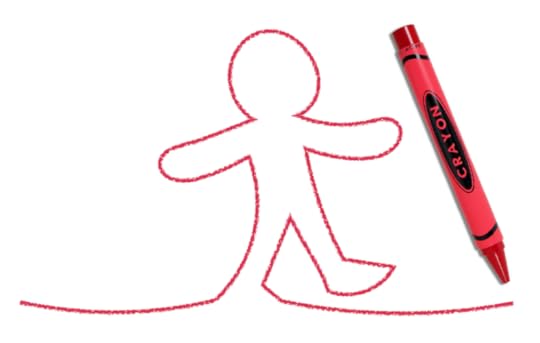 Drawing the anthropomorphic line
Drawing the anthropomorphic line The “Pig Tales” session I often do on my school and library visits features three picture books I’ve written about pigs. In between reading the three stories I explain that one of the things that makes them different from each other is how much anthropomorphism they use. I explain what this ridiculously long word means and why it’s such a useful tool for storytellers.
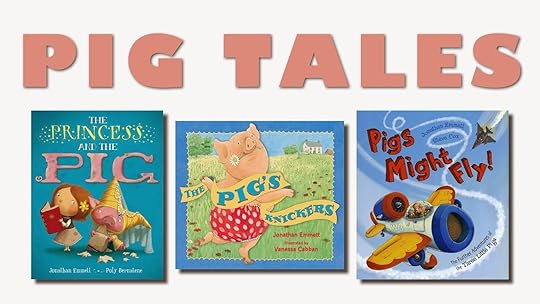
The dictionary definition of anthropomorphism is “the attribution of human characteristics or behaviour to a god, animal, or object.” I tell the children that anthropomorphism is simply “making something more like a person.”
Many of mankind’s oldest stories come from Africa, the birthplace of the human race. In the African stories of Anansi the spider, Anansi thinks and speaks like a human and in some of the stories he takes on human form.
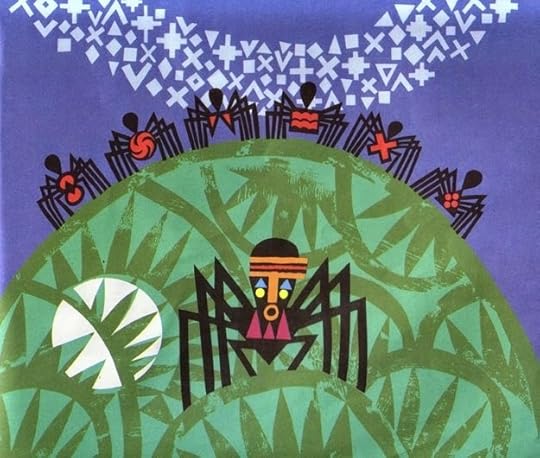 Anansi the Spider: A Tale from the Ashanti by Gerald McDermott
Anansi the Spider: A Tale from the Ashanti by Gerald McDermottStorytellers have been using anthropomorphism – making animals think and talk like humans – ever since.
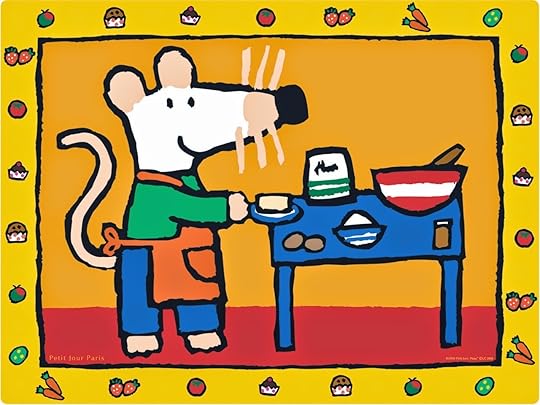 Lucy Cousins's Maisy Mouse
Lucy Cousins's Maisy MouseAnd it’s not just animals – you can anthropomorphise almost anything …

… vegetables …

… vehicles …
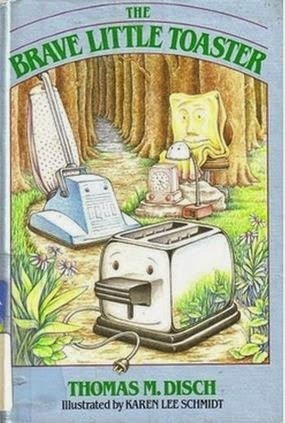
… even household appliances!
One reason storytellers use anthropomorphism is because people usually find characters more appealing if they think they are like them. Anthropomorphising an animal or even a toaster makes us care about what happens to them.
Anthropomorphism is not an either-or option; you can vary the amount you use. And, if you are creating a picture book, it’s worth taking the time to get the balance just right in both text and illustrations.
 You can use varying amounts of anthropomorphism
You can use varying amounts of anthropomorphismMy picture book story Pigs Might Fly is a sequel to the traditional tale of The Three Little Pigs. The pigs in my story build and fly aeroplanes, so they are fully anthropomorphic – the story could just as well be about three humans. This was reflected in some of illustrator Steve Cox’s first character sketches for the book, where the pigs are fully clothed and one of them is carrying a phone and a laptop. However, the publisher felt that these characters didn’t have quite the right appeal, and the character designs that eventually appeared in the book wore less clothing and were more recognisably pig-like.
 Some of Steve Cox's character sketches for Pigs Might Fly:
Some of Steve Cox's character sketches for Pigs Might Fly:Early, fully-anthropomorphic characters on the left and final characters on the right.
The pig in The Pig’s Knickers lives outdoors on a farm and – before the events of the story – would not usually wear clothing. However I made him talk, think and feel like a human in the text and Vanessa Cabban’s illustrations show him dancing on his hind legs and picking things up with his front trotters. As such, he’s a good example of a semi-anthropomorphic character.
 One of Vanessa Cabban's illustrations for The Pig's Knickers
One of Vanessa Cabban's illustrations for The Pig's KnickersThe Princess and the Pig is the story of a piglet that gets switched at birth and is brought up as a princess in the mistaken belief that she has been bewitched. The running joke in the story is that, while the reader knows that Princess Priscilla is nothing more than an ordinary pig, the characters in the story don’t and spend all their time trying to make her look and behave like a human. When I first started thinking about the story I considered making Priscilla a little anthropomorphic, but in the end I decided that the story would be much funnier if I didn’t anthropomorphise her at all.
 One of Poly Bernatene's spreads for The Princess and the Pig
One of Poly Bernatene's spreads for The Princess and the PigSo the next time you’re writing a story with animal* characters, take a moment to think about where’s the best place to draw your anthropomorphic line!
*Or vegetables or vehicles or household appliances!
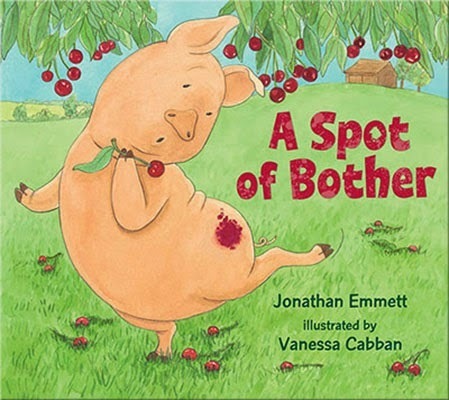 Jonathan Emmett's latest semi-anthropomorphic picture book is
A Spot of Bother
illustrated by Vanessa Cabban and published by Walker Books.
Jonathan Emmett's latest semi-anthropomorphic picture book is
A Spot of Bother
illustrated by Vanessa Cabban and published by Walker Books.
Find out more about Jonathan and his books at his Scribble Street web site or his blog. You can also follow Jonathan on twitter @scribblestreet.
See all of Jonathan's posts for Picture Book Den.
Published on March 20, 2015 23:30
March 16, 2015
Collaborative Writing by Abie Longstaff
In the Winter edition of The Author I saw an article by Terence Blacker called 'The seven habits of highly ineffective authors'. His final no no was this:

I totally disagree with him. In fact, the instant shaking of my head as I read his point made me realise how much I like to collaborate. All authors work differently; I know plenty who do work better alone: they get inspiration from long walks, from listening to music, from living inside their own heads. I'm not one of these: I'm a talker. I like to think aloud, chatting through my plots and characters with friends. I've always enjoyed this part of the process and I find the act of verbalising my story, and of having others question me on it, forces me to formulate it properly and to ensure the plot (in terms of action and emotion) makes sense.
I brainstorm with editors, with my husband and with fellow authors (Jane Clarke, Saviour Pirotta, Rebecca Lisle and I recently had a fantastic joint session talking through plots and characters). I like hearing what other people have to say and I like thinking about their book issues as well as my own.
Once I've written a first draft I often do manuscript swaps with authors (we do a monthly one here at picturebookden where any denner can send round a draft for comment), I show it to my agent and to my editors.
Funnily enough, it's not that common for picture book authors to collaborate with illustrators. Sometimes I don't ever meet my illustrator and the editor acts as a go-between. On Fairytale Hairdresser, because it is a series, Lauren Beard and I do talk through issues and plots and I love hearing her ideas on the text. When we were making the Snow Queen Lauren and I met up for coffee. She said; I'm thinking Russian-ish, I said; I'm thinking blue and spiky, and we ended up with this jointly inspired look:
 Recently I've heard a number of authors talk about more major scale collaboration: Sarah McIntyre and Phillip Reeve jointly authored the wonderful 'Oliver and the Seawigs' and they spoke at the Society of Authors about how enriching the experience was. Lee Weatherly and Linda Chapman talked at a conference about writing the 'Sophie and the Shadow Woods' series together and I know many other authors who write, or plot, with another person.
Recently I've heard a number of authors talk about more major scale collaboration: Sarah McIntyre and Phillip Reeve jointly authored the wonderful 'Oliver and the Seawigs' and they spoke at the Society of Authors about how enriching the experience was. Lee Weatherly and Linda Chapman talked at a conference about writing the 'Sophie and the Shadow Woods' series together and I know many other authors who write, or plot, with another person.
For me the phrase 'to be any good as an author you have to be on your own' just doesn't ring true. Where Blacker is right is that the final decision has to be mine, and I have to stand or fall based on it. But for me, listening to others makes my books deeper, richer and better.
What about you?

I totally disagree with him. In fact, the instant shaking of my head as I read his point made me realise how much I like to collaborate. All authors work differently; I know plenty who do work better alone: they get inspiration from long walks, from listening to music, from living inside their own heads. I'm not one of these: I'm a talker. I like to think aloud, chatting through my plots and characters with friends. I've always enjoyed this part of the process and I find the act of verbalising my story, and of having others question me on it, forces me to formulate it properly and to ensure the plot (in terms of action and emotion) makes sense.
I brainstorm with editors, with my husband and with fellow authors (Jane Clarke, Saviour Pirotta, Rebecca Lisle and I recently had a fantastic joint session talking through plots and characters). I like hearing what other people have to say and I like thinking about their book issues as well as my own.
Once I've written a first draft I often do manuscript swaps with authors (we do a monthly one here at picturebookden where any denner can send round a draft for comment), I show it to my agent and to my editors.
Funnily enough, it's not that common for picture book authors to collaborate with illustrators. Sometimes I don't ever meet my illustrator and the editor acts as a go-between. On Fairytale Hairdresser, because it is a series, Lauren Beard and I do talk through issues and plots and I love hearing her ideas on the text. When we were making the Snow Queen Lauren and I met up for coffee. She said; I'm thinking Russian-ish, I said; I'm thinking blue and spiky, and we ended up with this jointly inspired look:
 Recently I've heard a number of authors talk about more major scale collaboration: Sarah McIntyre and Phillip Reeve jointly authored the wonderful 'Oliver and the Seawigs' and they spoke at the Society of Authors about how enriching the experience was. Lee Weatherly and Linda Chapman talked at a conference about writing the 'Sophie and the Shadow Woods' series together and I know many other authors who write, or plot, with another person.
Recently I've heard a number of authors talk about more major scale collaboration: Sarah McIntyre and Phillip Reeve jointly authored the wonderful 'Oliver and the Seawigs' and they spoke at the Society of Authors about how enriching the experience was. Lee Weatherly and Linda Chapman talked at a conference about writing the 'Sophie and the Shadow Woods' series together and I know many other authors who write, or plot, with another person.For me the phrase 'to be any good as an author you have to be on your own' just doesn't ring true. Where Blacker is right is that the final decision has to be mine, and I have to stand or fall based on it. But for me, listening to others makes my books deeper, richer and better.
What about you?
Published on March 16, 2015 01:47
March 10, 2015
Endings that Stay With You
by Natascha Biebow
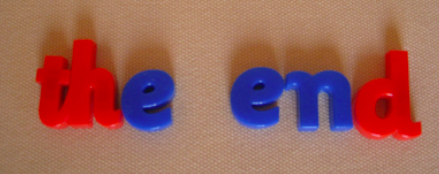
Wouldn’t it be great if there were a magic ‘ending machine’? You’d write your picture book and then feed it in and POOF! – out pops a spectacular ending!
Endings can be one of the most frustrating and nigglesome aspects of writing picture books. But when you’ve cracked it, a great ending can make the difference between that book that children ask for again and again, and the one they aren’t really fussed about ever reading again.
So, what makes a great ending?
• the main plot problem set up in the opening of the story must be resolved in a satisfactory way – the character’s hopes, wants and needs are met and realized.
• yourcharacters must grow and change by the end of the book – they should have learned something and will be bigger, better people as a result of their journey. So, by implication, will the reader.
• readers must feel satisfied and not be left hanging, wondering about unresolved plot points or sub-plots. All loose ends should be tied-up or dealt with.
Here are some examples where the reader can clearly see that the main character has gone on a journey and grown as a result of the action in the story:
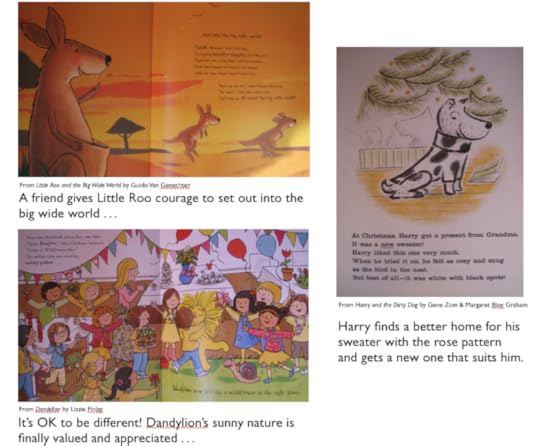
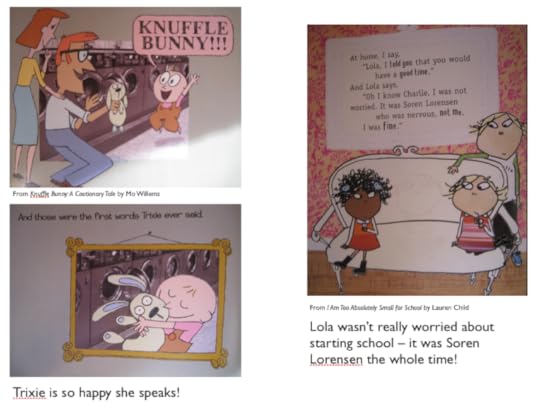
What other kinds of endings?
Dark endings: The ending of Jeanne Willis and Tony Ross' Tadpole's Promise is controversial, but true to nature. The caterpillar turns into a butterfly and gets eaten by her true-love, the Tadpole–turned frog. Some grown-ups may wonder: what will children make of this realistic and not at all happy ending?! It is memorable, though – and it works!
 From Tadpole's Promise by Jeanne Willis and Tony Ross
From Tadpole's Promise by Jeanne Willis and Tony Ross Circular endings: In A bit Lost by Chris Haughton, we see the classic ending that is the story starting all over again, with a slight twist. The story begins with Little Owl falling out of the nest and his quest for his mummy. Finally, reunited with her at last, Mummy invites his rescuers up to the nest, only for Little Owl to fall asleep again . . .
 The first and last spreads from A Bit Lost by Chris Haughton
The first and last spreads from A Bit Lost by Chris HaughtonUnexpected endings: In Flora's Flowers by Debi Gliori, there is a delightful surprise in store for young readers who believed in little Flora as she plants a small brick and declares, "I'm growing a small house." Her brothers and sisters all made fun of Flora while the seasons changed from Spring to Autumn and Winter to Spring again, but look what grew!
 From Flora's Flowers by Debi Gliori
From Flora's Flowers by Debi GlioriThe Baddie gets eaten up and everyone lives happily ever after: In traditional tales, the baddie often gets his comeuppance at the end of the story and meets a dastardly end, like the Troll in this retelling by Irene Yates of The Three Billy Goats Gruff:
 From The Three Billy Goats Gruff, illustrated by Ailie Busby
From The Three Billy Goats Gruff, illustrated by Ailie BusbyTwists: sometimes, the ending is a twist that is a delicious visual joke or surprise reveal, as in these two examples:

Or the twist is an unexpected plot turn, as in this example:

P.S. endings: Sometimes, the ending is not quite the end. When Kes' son read Billy's Bucket, he was concerned for the whale, who came out of the bucket onto the street when Billy's dad borrowed his bucket to clean the car without asking. How would the whale survive? So we added a postscript on the back endsheet, in which the whale was safely shoe-horned back into the bucket:
 From Billy's Bucket by Kes Gray & Garry Parsons
From Billy's Bucket by Kes Gray & Garry Parsons
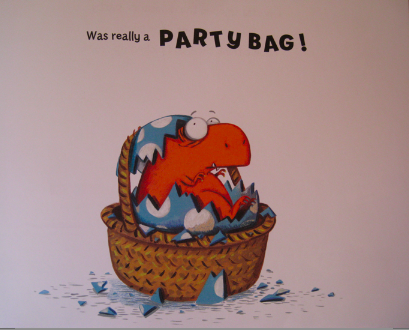 In another example: when Garry's son read The Dinosaurs are Having a Party by Garreth P Jones, he wondered: wouldn't the baby dinosaur who hatches out of the party bag egg miss his Daddy? Here is the solution on the back endsheet of the book:
In another example: when Garry's son read The Dinosaurs are Having a Party by Garreth P Jones, he wondered: wouldn't the baby dinosaur who hatches out of the party bag egg miss his Daddy? Here is the solution on the back endsheet of the book: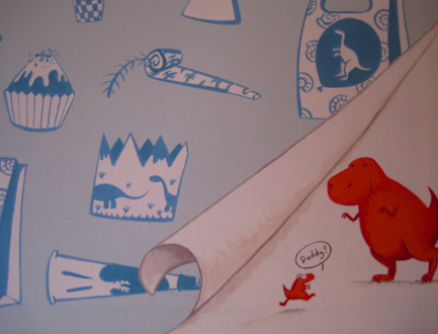 From The Dinosaurs are Having a Party
From The Dinosaurs are Having a Party by Garreth P Jones & Garry Parsons
The endings I like best are those that make me laugh or leave me with a warm feeling inside. They bring closure and a kernel of truth about life. Like these two:

What kinds of endings do you like?
_________________________________________________
Natascha Biebow Author, Editor and Mentor
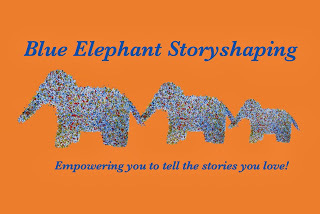 Blue Elephant Storyshaping is an editing, coaching and mentoring service aimed at empowering writers and illustrators to fine-tune their work pre-submission. Check out the NEW small-group coaching courses!
Blue Elephant Storyshaping is an editing, coaching and mentoring service aimed at empowering writers and illustrators to fine-tune their work pre-submission. Check out the NEW small-group coaching courses!Natascha is also the author of Elephants Never Forget and Is This My Nose?, editor of numerous award-winning children’s books, and Regional Advisor (Chair) of SCBWI British Isles. www.blueelephantstoryshaping.com
Published on March 10, 2015 21:00
March 6, 2015
What's your Other Life? - post by Jonathan Allen
As I've been at this job for a good thirty years or so, I think I can use the pompous phrase "In my long and varied career. ." without any exaggeration.
So, In my 'long and varied career' as a writer and illustrator, I have always had other interests bumping along in the back of the van, as it were. I suppose that, because I have never had what could be called a 'proper job', nothing that required travel to a place of work and a commitment to eight hours of labour of any kind, I don't compartmentalise my time. By which I mean that I don't feel I have to be doing any particular thing at a particular time of day. I am constrained by deadlines, but have free choice about when I do what in order to meet said deadlines.
I have lived long enough to realise that this is very unusual, and how lucky I am to be able to earn a living (of sorts) doing what I like and am good at. Basically I draw funny animals and get paid for it. . . Ridiculous. . .
 A Fat Cat - but you knew that.
A Fat Cat - but you knew that.
As what time I spend on what, is determined by me, I have been able to pursue other creative avenues in a fairly intensive way, deadlines permitting.
How about you? What interests do you have running parallel to your life a an author or illustrator?
I think creative people are inclined to use their creativity in all areas of life, after all it is a mindset rather than a 'hat' you put on from time to time. It would be interesting to know what strong interests other writers and illustrators have or have had in their lives alongside their writing and Illustrating careers, and how they feel it might feed back into their 'work'.
My list starts with music. I played bass in a band at art school, art school being one of the traditional places bands emerge from. We never got anywhere, but really wanted to for a while. From that I got interested in recording, and had a small studio in a house I lived in, with a couple of mates. I lost interest, as I hadn't got the level of commitment needed to spend long and antisocial hours in a darkened room with a rock band from Croydon (for instance). . .
 Status Shark, 5 string, passive electronics. Ho yes.
Status Shark, 5 string, passive electronics. Ho yes.
I got interested in computer related music tech and electronic music. Sampling etc, but again, didn't pursue it to any tangible end. (story of my life. .)
That led to an interest in computer generated landscape software, fractal based forms and how to make 'realistic' textures and patterns using them.
 This kind of thing - computer generated landscape from a good few years ago now. . .
This kind of thing - computer generated landscape from a good few years ago now. . .
I still mess with that stuff, but I now make abstract patterns and print the images onto ceramic tiles. Getting the patterns out onto real objects led me to polymer clay, which in turn led me to making beads and jewelry of a particular 'rustic' kind. I've started selling them online. . . (under another name so as to avoid confusion. .) I could never have predicted that one!
 'Rustic' Image Transfer beads, antiqued up to high heaven - fun to do
'Rustic' Image Transfer beads, antiqued up to high heaven - fun to do
I think it feeds back into what I do in that the same process of refining a rough idea into something finished goes on. (Well, obviously!) What I mean is that the process of structuring a good pop song, or bass line, or idea for a pendant etc is comparable to that of putting together good picture book. It's the same mindset at work, getting stuck in to the complex work that goes into producing something simple but solid in concept and execution.
Anyway, enough about me. What is and what has been your creative passion outside writing or illustrating, and has it been an inspiration or a distraction? (I think mine have been both at various times. . )
So, In my 'long and varied career' as a writer and illustrator, I have always had other interests bumping along in the back of the van, as it were. I suppose that, because I have never had what could be called a 'proper job', nothing that required travel to a place of work and a commitment to eight hours of labour of any kind, I don't compartmentalise my time. By which I mean that I don't feel I have to be doing any particular thing at a particular time of day. I am constrained by deadlines, but have free choice about when I do what in order to meet said deadlines.
I have lived long enough to realise that this is very unusual, and how lucky I am to be able to earn a living (of sorts) doing what I like and am good at. Basically I draw funny animals and get paid for it. . . Ridiculous. . .
 A Fat Cat - but you knew that.
A Fat Cat - but you knew that.As what time I spend on what, is determined by me, I have been able to pursue other creative avenues in a fairly intensive way, deadlines permitting.
How about you? What interests do you have running parallel to your life a an author or illustrator?
I think creative people are inclined to use their creativity in all areas of life, after all it is a mindset rather than a 'hat' you put on from time to time. It would be interesting to know what strong interests other writers and illustrators have or have had in their lives alongside their writing and Illustrating careers, and how they feel it might feed back into their 'work'.
My list starts with music. I played bass in a band at art school, art school being one of the traditional places bands emerge from. We never got anywhere, but really wanted to for a while. From that I got interested in recording, and had a small studio in a house I lived in, with a couple of mates. I lost interest, as I hadn't got the level of commitment needed to spend long and antisocial hours in a darkened room with a rock band from Croydon (for instance). . .
 Status Shark, 5 string, passive electronics. Ho yes.
Status Shark, 5 string, passive electronics. Ho yes.I got interested in computer related music tech and electronic music. Sampling etc, but again, didn't pursue it to any tangible end. (story of my life. .)
That led to an interest in computer generated landscape software, fractal based forms and how to make 'realistic' textures and patterns using them.
 This kind of thing - computer generated landscape from a good few years ago now. . .
This kind of thing - computer generated landscape from a good few years ago now. . .I still mess with that stuff, but I now make abstract patterns and print the images onto ceramic tiles. Getting the patterns out onto real objects led me to polymer clay, which in turn led me to making beads and jewelry of a particular 'rustic' kind. I've started selling them online. . . (under another name so as to avoid confusion. .) I could never have predicted that one!
 'Rustic' Image Transfer beads, antiqued up to high heaven - fun to do
'Rustic' Image Transfer beads, antiqued up to high heaven - fun to doI think it feeds back into what I do in that the same process of refining a rough idea into something finished goes on. (Well, obviously!) What I mean is that the process of structuring a good pop song, or bass line, or idea for a pendant etc is comparable to that of putting together good picture book. It's the same mindset at work, getting stuck in to the complex work that goes into producing something simple but solid in concept and execution.
Anyway, enough about me. What is and what has been your creative passion outside writing or illustrating, and has it been an inspiration or a distraction? (I think mine have been both at various times. . )
Published on March 06, 2015 00:06
March 1, 2015
More tips on writing children’s picture books, by Paeony Lewis
Right now I'm in the midst of tutoring a regular adult course on writing children’s picture books. Every week, two students read to us. They bring these books from home so we can experience a variety of tastes (sometimes the books aren't to my taste, which is good in an educational way!). We also experience a variety of voices and this is helpful in reminding us that some people relish reading aloud, and some don’t.

In real life, adults (parents, grandparents, carers, teachers, librarians, editors, etc.) won’t necessarily read our books the way we’re used to hearing them read in our heads or aloud to ourselves (or the cat and hamster). Maybe these adults won’t emphasise the ‘right’ bits, or they might use daft voices, or they rush or sound wearied after a long day. The book belongs to them – we have lost control.
When we write we can stress specific words in bold or large type, but the story can’t rely on a specific way of reading and we can't give adults voice auditions before they buy the book. So even without our control, a story needs to be good enough to be read in a variety of ways.
However, as a writer, when we read in our heads we always read our story a certain way. Therefore, here’s Tip 1: Find one or two friends who’ll read your manuscript TO YOU. They won’t necessarily read it how you think it ‘should’ be read. There are sure to be clunky bits. Don’t correct them! Go away and rewrite.
Listening to the students read in class also reminded me that as adults we forget what it’s like to sit quietly and listen to a grown-up share a picture book. The child may not be able to read and therefore, despite the illustrations, has to concentrate on the oral story. Illustrations help, but the child has to retain a lot of information.
I now appreciate how tricky this can be because when the students read the picture books on the writing course, they are too far away for me to be able to follow the words. Yikes! I found concentrating on the oral words would sometimes strain my brain (some of that may be because I have the attention span of a flickering light).
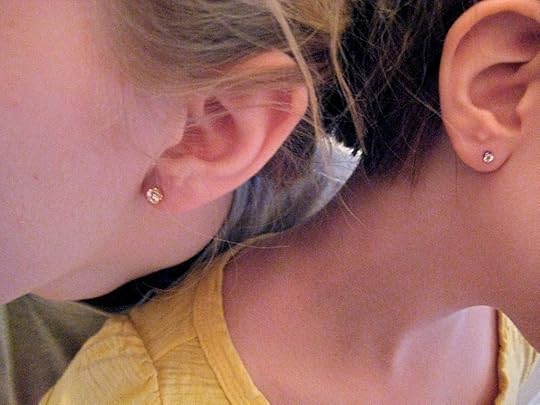
Whilst listening, several times I realised I hadn't begun to concentrate and missed the very start of the story. Or I wasn't captivated and my mind wandered. Plus it made me appreciate short texts that don't ramble. What was essential for me, apart from an interesting story, was a clear structure and patterning. A familiar pattern and some repetition helped to drive the story along and reinforce the story in my head, making it easier for me to focus. Mind you, too much unvarying repetition became tedious and I also stopped listening - sorry!
Tip 2: Repetition can help glue the storyline together and provide familiarity and fun. However, don’t overdo it and a lot of repetition requires some variety in the way it’s presented, and the occasional break in pace.
I shouldn't be surprised by this need for a beguiling story combined with clarity. Long before they were written down, everyone listened to traditional tales shared verbally around the fire. These tales needed a clear structure to be understood, often using the rule of three, and it made them easier to learn too. In addition, the characters in traditional tales are often given simple labels such as the prince, the queen, the old woman, the giant, the traveller or the pig or the fox. Alternatively, they had memorable monikers, such as Little Red Riding Hood and Snow White. It’s easier to keep track of what’s happening when there are labels, especially when there are several characters. I hadn't thought of it before, but perhaps it’s another legitimate reason for labelling some picture book characters Mother Bear, Baby Bunny, Little Grey Fox, etc.
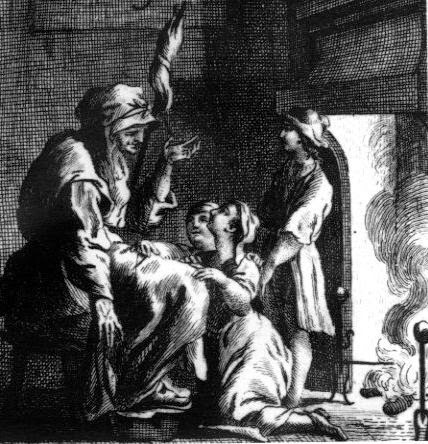
TIP 3: Remember the oral traditional tales and how a clear structure, patterning and repetition help the listener to follow the story. And try to avoid lots of complicated or similar names.
I suppose these three extra tips appear obvious, and they are, but I've found I can 'know' something without absorbing it, if that makes any sense? Then something happens (like having to really listen!) and the knowledge sinks in deeper. Anyway, happy writing, regardless of tips. There are no rigid rules - just what works for you and the publisher and the illustrator and the bookseller and the book buyer and the reader and listener...
Paeony Lewis
www.paeonylewis.com
Plus please click here for a list of links to my other blog posts on writing picture books.
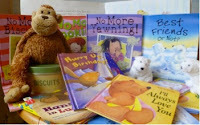

In real life, adults (parents, grandparents, carers, teachers, librarians, editors, etc.) won’t necessarily read our books the way we’re used to hearing them read in our heads or aloud to ourselves (or the cat and hamster). Maybe these adults won’t emphasise the ‘right’ bits, or they might use daft voices, or they rush or sound wearied after a long day. The book belongs to them – we have lost control.
When we write we can stress specific words in bold or large type, but the story can’t rely on a specific way of reading and we can't give adults voice auditions before they buy the book. So even without our control, a story needs to be good enough to be read in a variety of ways.
However, as a writer, when we read in our heads we always read our story a certain way. Therefore, here’s Tip 1: Find one or two friends who’ll read your manuscript TO YOU. They won’t necessarily read it how you think it ‘should’ be read. There are sure to be clunky bits. Don’t correct them! Go away and rewrite.
Listening to the students read in class also reminded me that as adults we forget what it’s like to sit quietly and listen to a grown-up share a picture book. The child may not be able to read and therefore, despite the illustrations, has to concentrate on the oral story. Illustrations help, but the child has to retain a lot of information.
I now appreciate how tricky this can be because when the students read the picture books on the writing course, they are too far away for me to be able to follow the words. Yikes! I found concentrating on the oral words would sometimes strain my brain (some of that may be because I have the attention span of a flickering light).

Whilst listening, several times I realised I hadn't begun to concentrate and missed the very start of the story. Or I wasn't captivated and my mind wandered. Plus it made me appreciate short texts that don't ramble. What was essential for me, apart from an interesting story, was a clear structure and patterning. A familiar pattern and some repetition helped to drive the story along and reinforce the story in my head, making it easier for me to focus. Mind you, too much unvarying repetition became tedious and I also stopped listening - sorry!
Tip 2: Repetition can help glue the storyline together and provide familiarity and fun. However, don’t overdo it and a lot of repetition requires some variety in the way it’s presented, and the occasional break in pace.
I shouldn't be surprised by this need for a beguiling story combined with clarity. Long before they were written down, everyone listened to traditional tales shared verbally around the fire. These tales needed a clear structure to be understood, often using the rule of three, and it made them easier to learn too. In addition, the characters in traditional tales are often given simple labels such as the prince, the queen, the old woman, the giant, the traveller or the pig or the fox. Alternatively, they had memorable monikers, such as Little Red Riding Hood and Snow White. It’s easier to keep track of what’s happening when there are labels, especially when there are several characters. I hadn't thought of it before, but perhaps it’s another legitimate reason for labelling some picture book characters Mother Bear, Baby Bunny, Little Grey Fox, etc.

TIP 3: Remember the oral traditional tales and how a clear structure, patterning and repetition help the listener to follow the story. And try to avoid lots of complicated or similar names.
I suppose these three extra tips appear obvious, and they are, but I've found I can 'know' something without absorbing it, if that makes any sense? Then something happens (like having to really listen!) and the knowledge sinks in deeper. Anyway, happy writing, regardless of tips. There are no rigid rules - just what works for you and the publisher and the illustrator and the bookseller and the book buyer and the reader and listener...
Paeony Lewis
www.paeonylewis.com
Plus please click here for a list of links to my other blog posts on writing picture books.

Published on March 01, 2015 00:00
February 24, 2015
Why I don't edit 'proper books' for grown-ups -by Katie Cotton
Our guest this week is Katie Cotton, an editor and author of children's picture books. She began her career at Templar and she is now part of the children's team at Frances Lincoln in London, where she is obviously working on some fabulous picture book material! Her blog is a reminder of the passion and enthusiasm to be found on the editor's side of the fence.
I'm quite often asked why I want to edit picture books. Sometimes − if I think the question is a thinly veiled "Why don't you want to edit 'proper' books for grown-ups?" − this irritates me. Sometimes, if the question occurs during an interview, it instantly makes me nervous. However, I always find the question interesting.
There are many reasons why I want to work in picture books. There's a magic in the interaction between the text and the pictures. I'm addicted to the 'turn of the page' moment and, of course, I believe that we need to create wonderful books for children that help them understand, and live in, the world around them.
However, the main reason is that in any reading experience, I'm looking for that indescribable moment when something is expressed so beautifully that the hairs on the back of my neck stand up, and this moment − for me − occurs in picture books more than any other genre.
It could be the moment when Polly Dunbar's penguin says, 'Everything!', or the moment when you see Shaun Tan's red tree, or the moment when the hungry caterpillar becomes a butterfly. These moments might (if you're anything like me) actually make you want to cry a little bit, but they do that because they make you feel something important, something true.
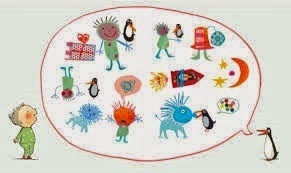 Polly Dunbar's penguin says 'Everything!', from the picture book Penguin.
Polly Dunbar's penguin says 'Everything!', from the picture book Penguin.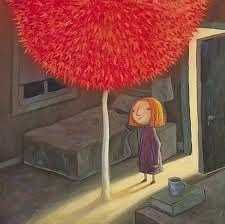 Shaun Tan's red tree, in The Red Tree.
Shaun Tan's red tree, in The Red Tree. I'm incredibly lucky that there are many, almost equally wonderful, moments in the job of making picture books. One is when you see a piece of art, perhaps at an illustration show or on an agency website, and you just know that it will be an incredible picture book. This was the case with David Litchfield, whose image of a city stopped me in my tracks.
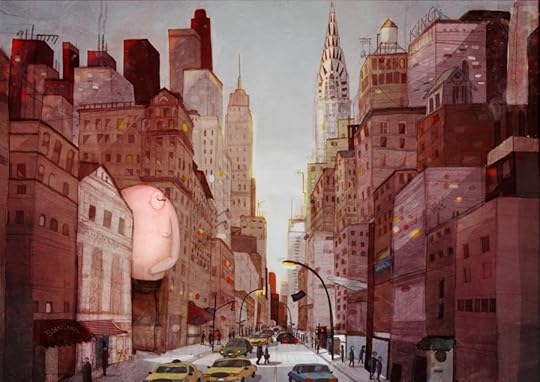 David Litchfield's image of a city. In the middle, when you're knee-deep in the process of making the book, there are also great moments. In early meetings I always ask authors what they think their book is about. If they could sum it up in a couple of sentences, what would they be? One of the best examples I've heard is Levi Pinfold's Black Dog, whose blurb sums it up perfectly:'This is a story about being scared. It is also a story about not being scared. It depends on how you see things.'
David Litchfield's image of a city. In the middle, when you're knee-deep in the process of making the book, there are also great moments. In early meetings I always ask authors what they think their book is about. If they could sum it up in a couple of sentences, what would they be? One of the best examples I've heard is Levi Pinfold's Black Dog, whose blurb sums it up perfectly:'This is a story about being scared. It is also a story about not being scared. It depends on how you see things.'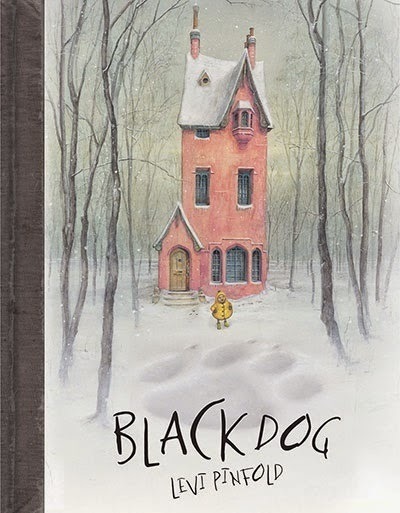 The cover of Black Dog by Levi Pinfold.Often, at the beginning of the process, authors can't sum up their book in this way. They might just have an image or a thought in their mind that they want to explore. Or they might have an idea of what the book is, but six or seven months down the line it may have morphed into something different, as books are sneaky things and have a habit of making their own views heard.
The cover of Black Dog by Levi Pinfold.Often, at the beginning of the process, authors can't sum up their book in this way. They might just have an image or a thought in their mind that they want to explore. Or they might have an idea of what the book is, but six or seven months down the line it may have morphed into something different, as books are sneaky things and have a habit of making their own views heard. This is all fine and a valuable part of the process; it's completely true that some of the best picture books take the longest time to make. But one of the best moments is the moment when it becomes clear what the book is going to be. It might occur when a character is drawn in a different pose, or during a discussion on the phone, or simply when a crucial sentence is written. Those 'That's it!' moments are worth their weight in gold.
David Litchfield's debut picture book, The Bear and the Piano, will be published this September, and what a stunner it is too. Both of us, and my colleagues at Frances Lincoln, can't wait, for of course that's another amazing moment: having the gorgeous finished book in your hands.

www.franceslincoln.com/childrens/www.davidlitchfieldillustration.com
Published on February 24, 2015 00:54
February 18, 2015
What's It All About? By Pippa Goodhart
What comes first; the story or the title? In my experience each book's writing process tends to be as individual as the book it results in. Sometimes a title is just there for the picking, seemingly obvious. I have a picture book called Chapatti Moon that’s being illustrated at the moment. I couldn’t have been called anything else. It's right for the story, and I love the sound of it. But on other occasions I have tied brain into knots, trying different word combinations to come up with a title I like. Titles are important because, along with cover artwork, they act as the lure to the story waiting inside a book. They give the reader clues as to what kind of story it will be, and they must tempt the reader inside so that the story itself gets a chance to grab them. A book cover is, almost literally, a door. We want people to open those doors. So, what few words writ bold on the front cover will make them do that?
A title might challenge us -
-
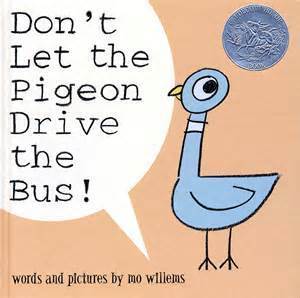 There’s a lovely threat of mayhem in the just the idea of a pigeon driving a bus. How will it work out?
There’s a lovely threat of mayhem in the just the idea of a pigeon driving a bus. How will it work out?They might be an instruction as to how you should use the book –
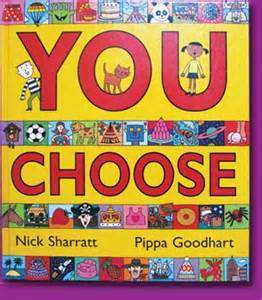
Simple, but hopefully tempting? What will there be to choose from?
They might boggle us with intriguing unknown words -
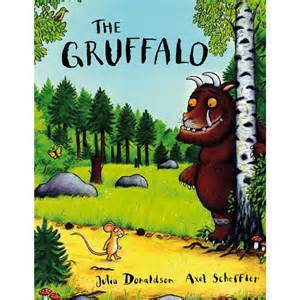
Now, of course, 'gruffalo' is a very well known word, but it was Julia Donaldson’s invention, designed, I gather, to offer lots of rhyming potential!
They can puzzle with something too obscure to let you guess what might be inside –
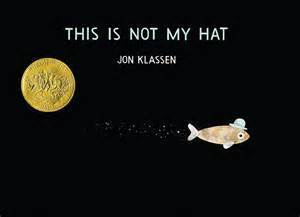
Why make a statement about a hat NOT being yours?
They might offer something tempting, but not give much away -
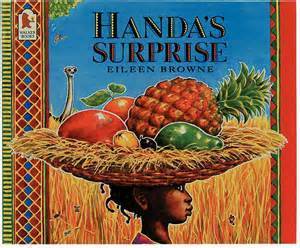
What IS the surprise?
Or they can be very straightforward –
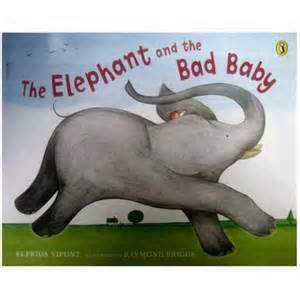
That’s a clear label, but far from dull because we have the intriguing combination of an elephant with a 'bad' baby. In what way is the baby 'bad'?
 This title is a very straightforward summary of the story. Boring? No, because we immediately think, but surely a tiger would already be wild? What’s going on here?
This title is a very straightforward summary of the story. Boring? No, because we immediately think, but surely a tiger would already be wild? What’s going on here? I think that the key to a good title is making the reader question. They know that if they open the book and read, they will find the answer. And the title must give something of the flavour of the story to come; perhaps to set its tone.Long titles usually mean that the words are there in a smaller font, perhaps even running into two or more lines, taking centre stage away from illustration.
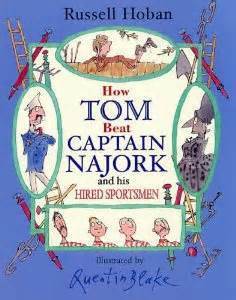
On the other hand, a single word can be bold -
[image error] Familiar words can trigger particular expectations. Many years ago when I was a bookseller, a publisher told me that some market research had been done into titles, and it was found that certain words would make book sales spike noticably. What were the magic words? Well, she said that the absolute optimum possible title for a children’s book (because it contained so many of the magic words) was The Little Lost Christmas Kitten. Guess what? There is no book of that title listen on Amazon. I offer it to you as a gift!
What I don’t offer you is a picture book that I want to write. I don’t know what the story is yet. But I want the title to be Mr Dull. My hope is that nobody would believe it. They’d instantly suppose that actually Mr Dull isn't dull, and they’d want to know how and why! Am I right? Is that how people would react, or would they be literal in their thinking and so pass that book over without a glance? What are your favourite picture book titles, and why?
Published on February 18, 2015 16:30
February 14, 2015
10 tips for buying a picture book present - by Moira Butterfield
The vast majority of picture books are bought as presents, and what a lovely present to give! Effectively you’re giving a child a precious door to the infinite world of the imagination, with the added bonus that it helps with the progress of reading and it provides a great play tool that adults and children can share together. Win, win, win. But how best to choose a picture book present? I often get asked this, so I've made a handy checklist that I hope will help present-givers and be a resource for authors who get asked the same question. Please add your own tips/observations!
 "Where shall we start?" 1. Buy chewable, wipeable, washable books for babies aged 0-2.
"Where shall we start?" 1. Buy chewable, wipeable, washable books for babies aged 0-2.If the child is still a baby, look for fabric books, books that can be wiped and books that look robust. There are plenty of these on the market designed specifically for babies, and safety tested for them, so there will be no toxicity or choking hazard. These books are in many ways more like toys, but they start the process of looking at images.Watch out for books with 'small parts' warnings on the back, as these are not suitable for the physical wear and tear babies give books. Countries have their own logos to show that books are safety tested and thus what age they are suitable for. In Europe it's the letters CE, for example. The information you need will be on the back cover.
 "Mmmm. Wipeable and chewable for me please!"
"Mmmm. Wipeable and chewable for me please!"
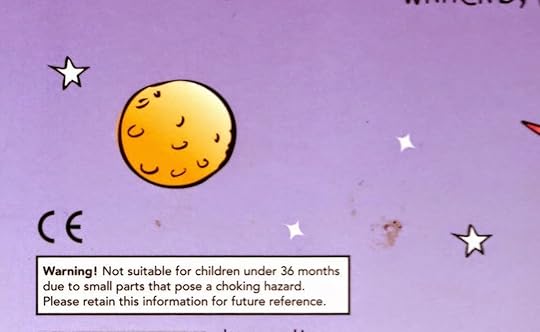 Look out for back cover safety warnings on books with small parts.
Look out for back cover safety warnings on books with small parts. 2. Buy 12-spread picture books for children aged 2 to 4. This is the core market for picture books. I know it's easy to buy on the internet but you can only see the cover and one or two pages, so I urge you to give yourself a treat and go to a proper bookshop to see the fantastic selection on offer. The amazing illustrations you find will blow you away. There are also lots of great board books for this age-group, with flaps etcetera, but for a present that will physically last the test of time (with no pieces to tear) I’d recommend the straight picture book route.
 "I'm 2. I love reading with my grown-ups and I like looking at the pictures on my own."
"I'm 2. I love reading with my grown-ups and I like looking at the pictures on my own." 3. Don’t buy something that’s too babyish for a child aged 4 to 5. Picture books are still ideal, but look for a story that is likely to grab their more sophisticated attention.
4. Don’t buy a picture book without reading it yourself. It won’t take long and the bookseller ought to be fine about it. Would you yourself like to read it out loud? I guess you’re not going to read a book out loud in a shop, but imagine you are doing that as you read it through. Look for imaginative language and something that will hold your child’s attention but basically make sure that you yourself, the buyer, like it.
5. Be careful in bargain bookstores. Do make extra sure you read the story through when buying from bargain bookstores. Some (though not all) bargain books are produced specifically for a bargain store, with no author involvement because the publisher wanted to cut costs and didn't budget any money for the text. They may have slammed something together in-house and rushed it through on a tight schedule, with very little thought.
6. Make a quick check of the page layout. Text that is well laid out on the page will be easier to read. Avoid a layout where the text seems to be plonked on in a messy way, perhaps with single words floating on their own at the bottom of a sentence (these are called 'widows' in old-fashioned print-speak).
A widow is a single word that is all forlorn like this.
If this is the case, the chances are that the editor and designer haven’t thought about this book much. It will be hard to read smoothly.
7. Choose a book with pictures that you love. There are some utterly fabulous illustrators out there, so don’t just grab any old book because it’s cheap. For a special present that will inspire and be treasured I urge you to choose something that’s a unique work of art. It makes for a classier present. My own mother liked the Anholts and gave my children some of their lovely books, along with some beautiful books by Inga Moore that we may never have seen ourselves but we will always treasure.
8. Choose a book that seems to be well-made. Some books are cheap because the publisher has skimped on the quality. The paper may be low-quality, absorbing ink and making the illustration look muddy. The binding (the bit that holds the book together down the centre) may easily come apart. Generally if the paper seems cheap then the binding won’t be of the best quality.
9. Look on the back of the book to see if your picture book paper comes from a forest-friendly source. Different countries will have different schemes for this, but publishers who take care in this area will add the logos and wording of their national scheme.
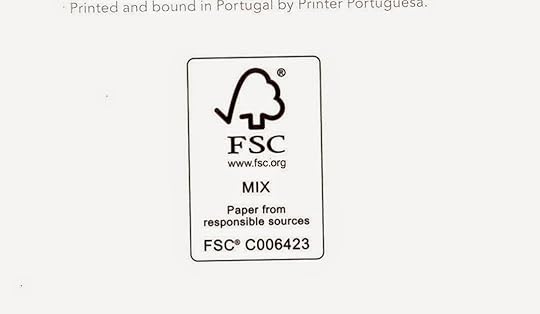 This UK logo confirms that the paper came from a forest-friendly source.
This UK logo confirms that the paper came from a forest-friendly source. 10 It boils down to this. Go to a real bookshop. Have fun choosing a book you love. Then you can be proud to hand it over!
 "Ooh, tractors! Good pressie! Thanks!"
"Ooh, tractors! Good pressie! Thanks!" With thanks to baby Ellie and friends, who showed us how best to chew books. Thanks to Milly in the middle, who is currently loving Tabby McTat, and Ben, who has always loved books on tractors. Perhaps one day he will become a fantastic farmer or an amazing engineer partially thanks to those lovely grown-ups who gave him thoughtfully-chosen picture books as presents.
Moira Butterfield
www.moirabutterfield.com
Published on February 14, 2015 00:58
February 9, 2015
Wannabe a Picture Book Editor for a Day? by Malachy Doyle
Right. Rather than me trying to tell anyone how to do it, this week it's over to you. Tell me what's wrong with this story. Whatever you say is helpful.
I like the story. Agent likes the story. But fears it's too 'quiet' for the current market.
I'm somewhat perplexed. What does 'quiet' mean? Too domestic? Too small in scale? Not enough pirates, dinosaurs, underpants...?
Or maybe part of the trouble is it rhymes (shock horror)?
The Littlest One
One day all the others – Pip, Stevie and Sam –
rushed off to the playground. The front door went slam!
‘Wait!’ yelled the Little One. ‘Rats!’ was her cry –
for the handle was up near the top – far too high.
She tried all the doors but she couldn’t get out.
‘I’m fed up! So fed up!’ she started to shout. ‘I’m fed up with being the Littlest One!I want to be out there! I want to have fun! I’m fed up with THEM telling me what to do!
And I’m fed up with THEM always getting things new
while I get their hand-me-downs – old stuff from others –
WHO NEEDS BIG SISTERS? OH WHO WANTS BIG BROTHERS!’
She stomped up and down till she came to a door.
(of an old neglected wendy house, in the playroom)
‘We all used to play here, we don’t any more.
It’s too small for Pip or for Stevie or Sam,
but it’s just right for Little Ones – that’s what I am!’
She gathered up toys – they were Little Ones, too.
‘Let’s have some fun!’ she said. ‘Just me and you!
We won’t ask those others – they’ve all grown so tall.
They don’t fit in here but it’s good, being small!’
She reached out for Badger, she grabbed hold of Pig,
and soon they were whirling and dancing a jig.
Ragdoll and Teddy Bear – they joined in, too,
and the wendy house shook with the hullabaloo.
‘For the Littlest One, oh the Littlest One,
yes the Littlest One has the VERY BEST FUN!’
‘Can we join in too?’ cried her brothers and sister.
Now they were home, they were sorry they’d missed her –
sorry they’d missed the best game of the day. ‘No, you’re all too grown-up! You can just GO AWAY!’
‘But I can see TEDDY!’ cried Sam, at the door.
‘And my DOLL!’ shouted Pip. ‘There she is, on the floor!’ ‘They’re not yours any more and he’s not Stevie’s Pig!
You gave them to me when you all got too big!
Too big for the wendy house, too big to play,
too big for “baby games” – you went away!
But the Littlest One, oh the Littlest One,
yes the Littlest One has the VERY BEST FUN!’
‘Oh please!’ cried the rest. ‘Can’t we just have a go?’
‘Well, you can if you fit…’ said the Little One so
Sam squeezed in the window, Pip squashed through the door
and while Stevie played fiddle, they whirled round some more.
‘We’re sorry we left you!’ said Pip, Steve and Sam.
And they sang and they danced. Even Dad did, and Mam!
Yes they laughed and they giggled until Granma said,
‘All playing together – what fun! Time for bed!’
So they danced up the stairs, all still doing a jig –
for you’re never too big for a whirly-ma-gig.
No you’re never too old to have oodles of fun,
for remember – you once were the Littlest One.
Yes, everyone once was the Littlest One. (Even Granma!)
‘For the Littlest One! Yes, the Littlest One! Oh the Littlest One has the VERY BEST FUN!’ (bouncing on the bed with Granma)
I like the story. Agent likes the story. But fears it's too 'quiet' for the current market.
I'm somewhat perplexed. What does 'quiet' mean? Too domestic? Too small in scale? Not enough pirates, dinosaurs, underpants...?
Or maybe part of the trouble is it rhymes (shock horror)?
The Littlest One
One day all the others – Pip, Stevie and Sam –
rushed off to the playground. The front door went slam!
‘Wait!’ yelled the Little One. ‘Rats!’ was her cry –
for the handle was up near the top – far too high.
She tried all the doors but she couldn’t get out.
‘I’m fed up! So fed up!’ she started to shout. ‘I’m fed up with being the Littlest One!I want to be out there! I want to have fun! I’m fed up with THEM telling me what to do!
And I’m fed up with THEM always getting things new
while I get their hand-me-downs – old stuff from others –
WHO NEEDS BIG SISTERS? OH WHO WANTS BIG BROTHERS!’
She stomped up and down till she came to a door.
(of an old neglected wendy house, in the playroom)
‘We all used to play here, we don’t any more.
It’s too small for Pip or for Stevie or Sam,
but it’s just right for Little Ones – that’s what I am!’
She gathered up toys – they were Little Ones, too.
‘Let’s have some fun!’ she said. ‘Just me and you!
We won’t ask those others – they’ve all grown so tall.
They don’t fit in here but it’s good, being small!’
She reached out for Badger, she grabbed hold of Pig,
and soon they were whirling and dancing a jig.
Ragdoll and Teddy Bear – they joined in, too,
and the wendy house shook with the hullabaloo.
‘For the Littlest One, oh the Littlest One,
yes the Littlest One has the VERY BEST FUN!’
‘Can we join in too?’ cried her brothers and sister.
Now they were home, they were sorry they’d missed her –
sorry they’d missed the best game of the day. ‘No, you’re all too grown-up! You can just GO AWAY!’
‘But I can see TEDDY!’ cried Sam, at the door.
‘And my DOLL!’ shouted Pip. ‘There she is, on the floor!’ ‘They’re not yours any more and he’s not Stevie’s Pig!
You gave them to me when you all got too big!
Too big for the wendy house, too big to play,
too big for “baby games” – you went away!
But the Littlest One, oh the Littlest One,
yes the Littlest One has the VERY BEST FUN!’
‘Oh please!’ cried the rest. ‘Can’t we just have a go?’
‘Well, you can if you fit…’ said the Little One so
Sam squeezed in the window, Pip squashed through the door
and while Stevie played fiddle, they whirled round some more.
‘We’re sorry we left you!’ said Pip, Steve and Sam.
And they sang and they danced. Even Dad did, and Mam!
Yes they laughed and they giggled until Granma said,
‘All playing together – what fun! Time for bed!’
So they danced up the stairs, all still doing a jig –
for you’re never too big for a whirly-ma-gig.
No you’re never too old to have oodles of fun,
for remember – you once were the Littlest One.
Yes, everyone once was the Littlest One. (Even Granma!)
‘For the Littlest One! Yes, the Littlest One! Oh the Littlest One has the VERY BEST FUN!’ (bouncing on the bed with Granma)
Published on February 09, 2015 01:54



